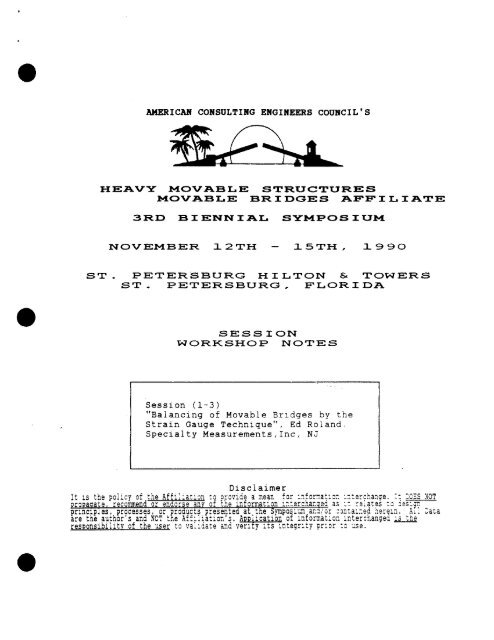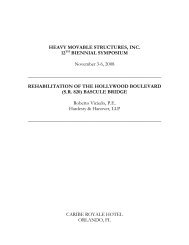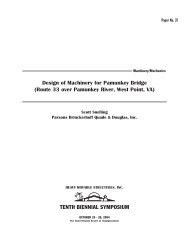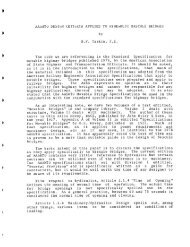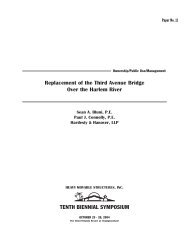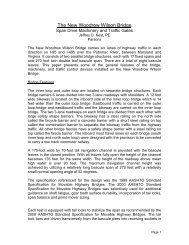Balancing of Movable Bridges by the Strain Gauge Technique
Balancing of Movable Bridges by the Strain Gauge Technique
Balancing of Movable Bridges by the Strain Gauge Technique
Create successful ePaper yourself
Turn your PDF publications into a flip-book with our unique Google optimized e-Paper software.
At4ERICM CONSULTING ENGINEERS COUNCIL'SHEAVY MOVABLE STRUCTURESMOVABLE BRIDGES AFFILIATE3RD BIENNIAL SYMPOSIUMNOVEMBER 12TH - 15TH, 1990ST. PETER'SBURG HILTON b TOWERSST. PETERSBURG, FLORIDASESSIONWORKSHOP NOTESSesslon (1-3)"<strong>Balancing</strong> <strong>of</strong> <strong>Movable</strong> <strong>Bridges</strong> <strong>by</strong> <strong>the</strong><strong>Strain</strong> <strong>Gauge</strong> <strong>Technique</strong>", Ed Roland,Specialty Measurements,Inc, NJDisclaimerIt 1s :he policy <strong>of</strong> :he Rffi;:a::an r3 ?r~v;ie a ;?an f ~ ::fonaj~::. r:,r?r;!iange. :; 3C3S SOTo r ~ are ~ a recormend or endorse any 3f rne :nfor~,a;:on x:srcnar.?eo as 1: :?;aces :: :?s:;?princ;p;es, processes, or 3 3 UC:S presEitea a .<strong>the</strong> pmpos:.+3 aar./sr r3n:a:r.eJ. i?rerr.. A.: ;araare tiieauihor's and XC: <strong>the</strong> ;ff ljaiiox'j. Aok,icai;on <strong>of</strong> infomatio;, :nter:aangeiresponsibilitv <strong>of</strong> <strong>the</strong> :iser t3 va.:Sate ana verify its :ntegri:y pr~3r 23 :se.
Table <strong>of</strong> ContentsINTRODUCTIONTEST METHODDATA REDUCTIONCASE STUDY NO. 1CASE STUDY NO. 2CASE STUDY NO. 3CASE STUDY NO. 4
IntroductionSeveral moveable bridges were built in <strong>the</strong> United States during <strong>the</strong>mid and early 20th century. To prolong <strong>the</strong> life and reduce costlyequipment replacement and refurbishing, <strong>the</strong> bridge should bemaintained in a good operating balance state.The two major bridge types considered here are vertical liftbridges and bascule span bridges. Vertical lift, much like anelevator, are raised <strong>by</strong> cables at each <strong>of</strong> <strong>the</strong> four corners <strong>of</strong> <strong>the</strong>span. The cables are suspended from pulleys supported <strong>by</strong> towers.The weight <strong>of</strong> <strong>the</strong> span are balanced <strong>by</strong> a counterweight attached to<strong>the</strong> cables on <strong>the</strong> opposite side <strong>of</strong> <strong>the</strong> pulleys.There are two major types <strong>of</strong> bascule bridges. These are trunnionand roller types. A trunnion type consists <strong>of</strong> a deck supportingleaf and a counterweight that pivots about a fixed trunnionbearing. The roller type bascule bridge consists <strong>of</strong> a leaf andcounterweight that pivot about <strong>the</strong> axis <strong>of</strong> a large roller. Rollerbridges rotate and move horizontally during its operation.Both bridge types can develop excessive imbalances caused <strong>by</strong> deckrehabilitation, addition <strong>of</strong> utilities, dirt accumulation, paint,and numerous o<strong>the</strong>r reasons. These imbalances can increaseoperating power requirements and machine wear, and in extreme casescause equipment failure and create potential hazardous conditions.Several methods exist to balance a bascule bridge, but most providean incomplete picture <strong>of</strong> <strong>the</strong> full balance state <strong>of</strong> <strong>the</strong> bridge.This paper will present a method <strong>of</strong> determining <strong>the</strong> balance state<strong>of</strong> a bascule bridge using strain gages on <strong>the</strong> final pinion shafts.The gages are used to measure operating torque during <strong>the</strong> raisingand lowering <strong>of</strong> <strong>the</strong> span. For vertical lift bridges <strong>the</strong> data canbe used to determine <strong>the</strong> present balance state and trunnionfriction. For bascule bridges <strong>the</strong> resulting data can be used to
determine <strong>the</strong> horizontal and vertical eccentricity <strong>of</strong> <strong>the</strong> imbalanceload, trunnion or roller friction, plus information on <strong>the</strong>performance on <strong>the</strong> mechanical drive components.
Test MethodThis test method for balancing <strong>the</strong> movable bridge described hererequires <strong>the</strong> installation <strong>of</strong> strain gages on <strong>the</strong> final pinion driveshaft. Four (4) strain gages are installed on each final pinionshaft in a full wheatstone bridge configuration. The orientation<strong>of</strong> <strong>the</strong> gages used in this test measures shaft torque and cancelsout <strong>the</strong> effects <strong>of</strong> direct shear, moment and axial loading (SeeFigure 1). A full bridge is also temperature compensating. A fourconductor individual shielded pair cable with a common wireconnects <strong>the</strong> shaft gages to <strong>the</strong> strain gage signal conditioningsystem. The cable shielding is grounded at <strong>the</strong> signal conditioningsystem only.On bascule bridges an inclinometer is mounted to <strong>the</strong> span to detect<strong>the</strong> angle <strong>of</strong> <strong>the</strong> bridge during its operation. The amplified straingage output and inclinometer voltages are recorded on an analogtape recorder during <strong>the</strong> test.Before testing <strong>of</strong> <strong>the</strong> bridge, <strong>the</strong> strain gage signals must becalibrated and <strong>the</strong>n zeroed at a no load state <strong>of</strong> <strong>the</strong> pinion shaft.The gages are calibrated <strong>by</strong> <strong>the</strong> use <strong>of</strong> a shunt calibrationresistor. The resistor is temporarily connected in parallel acrossone <strong>of</strong> <strong>the</strong> gages to simulate a strain in <strong>the</strong> shaft (typically 50microstrain). The resistor can be connected at <strong>the</strong> gages whichwill account for <strong>the</strong> effects <strong>of</strong> lead wire resistance. The shuntresistor can also be connected at <strong>the</strong> signal conditioner and <strong>the</strong>
effects <strong>of</strong> lead wire resistance manually calculated. Thecalibration strain signals are recorded for each strain gage bridgeand is used as a reference when interpreting <strong>the</strong> actual shaftstrains.The gages are zeroed using <strong>the</strong> signal conditioning system when <strong>the</strong>pinion shaft is in a zero load state. To set a zero load state<strong>the</strong> span locking pins are engaged while <strong>the</strong> braking system ismanually released. The operating machinery is manually rotated totake up <strong>the</strong> backlash in one direction, <strong>the</strong>n <strong>the</strong> o<strong>the</strong>r. This willlocate <strong>the</strong> mid-position so that <strong>the</strong> pinion can float between <strong>the</strong>drive rack or gear teeth. If <strong>the</strong> positioning is correct and <strong>the</strong>pinion is not loaded at this point <strong>the</strong> output <strong>of</strong> <strong>the</strong> gages will notrespond to <strong>the</strong> passage <strong>of</strong> a live load.Typically three tests are run with data being recorded during both<strong>the</strong> raising and lowering <strong>of</strong> <strong>the</strong> span. Especially in <strong>the</strong> case <strong>of</strong>bascule spans, it is advantageous to operate <strong>the</strong> bridge to its fulllimits <strong>of</strong> opening to collect as many data points as possible. Thebridge should also be operated at a constant speed to reduceinertia effects. Testing under severe wea<strong>the</strong>r or with ice and snowaccumulating should be avoided. A typical single leaf test traceis presented in Figure 2.
Data ReductionTo analyze <strong>the</strong> balance state <strong>of</strong> <strong>the</strong> bridge, shaft strain must beconverted into operating load for vertical lift bridges or leafmoments for bascule spans. For both bridge types, this begins withdetermining pinion shaft torque during operation.The equations to convert strain to pinion shaft torque are asfollows:EauationNo. 1: €cat = %/ [(%+R,) XG-F.)INo. 2: T - aG2A: c - a/ 22B: r - 2 EG2c: c - E/E2 x (1 + ~ ) 12D: T - 2€E/[2 x (1 + p)] = rE/(l + p)NO. 3: J - RD~/ 323A: c - D/ 23B: J/c - RD~/ 16NO. 4: r T, c/J4A: Ts - rJ/c-
€4= Calibration strain for R'% = Resistance <strong>of</strong> <strong>Strain</strong> Gage (OHMS)% = Resistance <strong>of</strong> Calibration Shunt (OHMS)G.F. = Gage Factor for <strong>Strain</strong> Gages (provided <strong>by</strong> Manufacturer)T = Torsional Shear Stress (PSI)Q = Shear <strong>Strain</strong> (inch per inch)G = Shear Modulus for Shaft MaterialE = Measured <strong>Strain</strong> (inch per inch)E = Young's Modulus for Shaft Material = 30 x lo6 PSIP = Poisson's Ratio = .3J = Polar Moment <strong>of</strong> InertiaD = Pinion Shafk Diameter (inches)c = Distance from Neutral Axis to <strong>Strain</strong> GageTsMG.R.rL= Pinion Shaft Torque (inch pounds)= Bascule Imbalance Moment (inch pounds)= Gear Ratio Between Pinion Shaft and Bascule Span Rotationor Lift Bridge Bull Gear Rotation= Radius <strong>of</strong> <strong>the</strong> Sheave Pulley (Lift <strong>Bridges</strong>)= Tension load on a cable group (Lift <strong>Bridges</strong>)Solving Equation 2D: r = eE/(l + P)Where :E = 30 * lo6p = 0.3Produces :r = (23.1) (PC)Inserting that value into equation 4A: T, = s J/cWhere :J/c = n~~/16 (equation 3B)
For bascule spans, leaf moment is determined <strong>by</strong>;For vertical lift, lift load is determined <strong>by</strong> load;In both cases, strain can be converted into <strong>the</strong> desired load <strong>by</strong> asingle conversion factor.The strain gage output during operation is a complex wave form.Much <strong>of</strong> <strong>the</strong> low frequency signal (.5 Hz to 10 Hz) is generated <strong>by</strong><strong>the</strong> individual teeth <strong>of</strong> <strong>the</strong> drive gears. The magnitude <strong>of</strong> <strong>the</strong>strain due to <strong>the</strong> gears can be greater than <strong>the</strong> strain due to <strong>the</strong>span imbalance. To extract <strong>the</strong> strain due to imbalance a smoothcurve can be drawn through <strong>the</strong> total strain trace. The signal canalso be played back through a low frequency filter when <strong>the</strong> signalis converted into a digital form. A computer can be utilized t<strong>of</strong>ilter <strong>the</strong> signal <strong>by</strong> several various criteria, most <strong>of</strong>ten <strong>by</strong> pointaveraging.The operating friction <strong>of</strong> <strong>the</strong> bridge beyond <strong>the</strong> pinion shaft isdetermined <strong>by</strong> halving <strong>the</strong> difference <strong>of</strong> <strong>the</strong> raising and loweringload histories. To determine <strong>the</strong> imbalance loads without friction,.<strong>the</strong> raising and lowering load histories are averaged.For a vertical lift bridge <strong>the</strong> data reduction would be complete atthis point. For a bascule bridge, <strong>the</strong> vertical and horizontalcomponent <strong>of</strong> <strong>the</strong> imbalance must be determined. To do thisresulting load histories from all pinion shafts in a leaf are addedtoge<strong>the</strong>r. The cosine curve that best fits <strong>the</strong> data points must bedetermined. This is most <strong>of</strong>ten accomplished using a computerprogram.
The results <strong>of</strong> <strong>the</strong> program provide:1. The <strong>the</strong>oretical maximum moment (<strong>the</strong> angle <strong>of</strong> <strong>the</strong> lift thatthis moment would develop at may be beyond <strong>the</strong> actual range<strong>of</strong> angles <strong>the</strong> bridge operated within).2. The angle <strong>of</strong> lift that <strong>the</strong> bridge experiences <strong>the</strong> moment.3. The vertical and horizontal component <strong>of</strong> <strong>the</strong> <strong>the</strong>oreticalmaximum moment when <strong>the</strong> bridge is in <strong>the</strong> closed position.4. The operating friction.5. The degree <strong>of</strong> fit <strong>of</strong> <strong>the</strong> cosine curve.Refer to Figure 3 for items 1 - 5.Adiustinq <strong>the</strong> Balance StateAdjusting <strong>the</strong> balance state <strong>of</strong> a vertical lift bridge usuallyentail <strong>the</strong> addition or removal <strong>of</strong> weight from counterweight. Thisalone can produce <strong>the</strong> most desired balance states.The balancing <strong>of</strong> a bascule bridge requires considering <strong>the</strong> verticaland horizontal components <strong>of</strong> <strong>the</strong> bridge imbalance and <strong>of</strong> <strong>the</strong>available balancing weight locations.Operating load conditions can be predicted for any change in <strong>the</strong>bascule span balance state. This is performed <strong>by</strong>:1. Calculating <strong>the</strong> total <strong>of</strong> <strong>the</strong> weights to be removed and added.2. Calculating <strong>the</strong> center <strong>of</strong> gravity <strong>of</strong> <strong>the</strong> new in weight andits vertical and horizontal distanced referenced from <strong>the</strong>center <strong>of</strong> rotation <strong>of</strong> <strong>the</strong> bascule span.
3. Calculate <strong>the</strong> vertical and horizontal moments caused <strong>by</strong> <strong>the</strong>new weights.4. Add <strong>the</strong>se moments to <strong>the</strong> corresponding existing balance statemoments.5. Calculate <strong>the</strong> new maximum <strong>the</strong>oretical moment and its angle.6. Construct a cosine curve in phase with <strong>the</strong> lift angles witha magnitude equal to <strong>the</strong> maximum moment and a phase shiftequal to its angle.This will produce a new balance curve. Friction can be added toproduce <strong>the</strong> new opening and closing load curves. If <strong>the</strong> weight tobalance <strong>the</strong> bridge is significant <strong>the</strong> friction can be adjusted <strong>by</strong><strong>the</strong> factor <strong>of</strong>:New Dead Load-------------Old Dead LoadThese operating curves can <strong>the</strong>m be examined to see if <strong>the</strong>y fallwithin acceptable limits.
-120 KIP FEETA = HORrZONTAL MOMENTB = VERTICAL MOMENTWL= MAXIMUM MOMENTA= WL CDS ANGLEB= WL SIN ANGLEJfigure 3, EXAMPLE BASCULE BALANCE STATE
The Balance StateNo set standard <strong>of</strong> bridge balance has been widely established with<strong>the</strong> condition <strong>of</strong> balance usually being determined <strong>by</strong> <strong>the</strong> Engineer.The factors considered in determining <strong>the</strong> best balance state are<strong>of</strong>ten:SafetyWhen balancing <strong>the</strong> span, it is desireable that with <strong>the</strong> motor <strong>of</strong>fand <strong>the</strong> brakes released <strong>the</strong> span should not raise from its loweredposition. On most bridges, this usually entails making <strong>the</strong> bridgeslightly span heavy. On many bascule bridges <strong>the</strong> counterweight ispart <strong>of</strong> <strong>the</strong> deck structure. A live load passing over <strong>the</strong>counterweight will tend to lift <strong>the</strong> span. Increasing <strong>the</strong> leafweight or reducing <strong>the</strong> counterweight may be necessary to counterthis effect.Machine Wear and LoadMuch <strong>of</strong> <strong>the</strong> financial gains to be made <strong>by</strong> balancing a bridge arein increased equipment life. This is accomplished <strong>by</strong> reducedoperating loads. Span loads can be made to lessen with opening oreven made negative at <strong>the</strong> fully opened position if desired.Structural WearWhen lowered, <strong>the</strong> spans should be well seated on <strong>the</strong> live loadbearing to reduce pumping <strong>of</strong> <strong>the</strong> bearings. This minimizes anunwanted transmission <strong>of</strong> loads through <strong>the</strong> structure and <strong>the</strong>transmission <strong>of</strong> undue load to <strong>the</strong> drive machinery. The spanlifting forces should be applied evenly to <strong>the</strong> structure to avoidtorquing <strong>of</strong> <strong>the</strong> span.
@Computerized Data Acquisition and Ana1jsis SystemThe test method described in this paper involves <strong>the</strong> recording <strong>of</strong>an analog signal for playback during analysis. A computerized dataacquisition and analysis system has been developed to provide onsiteresults. The strain gage and inclinometer signals (whereapplicable) are entered directly to <strong>the</strong> system and converted to adigital form. At <strong>the</strong> end <strong>of</strong> each test, <strong>the</strong> system can provide <strong>the</strong>present balance state, predict <strong>the</strong> load curves for proposed weightchanges, and recommend weight changes based on available weightlocations.The system has <strong>the</strong> advantage <strong>of</strong> producing instant results. Thismeans results are available soon after changes in <strong>the</strong> weights havebeen made. These can be used to verify <strong>the</strong> effects <strong>of</strong> <strong>the</strong> weightchanges and if needed recommend fur<strong>the</strong>r fine tuning <strong>of</strong> <strong>the</strong> weightplacement.The system is more compact and lighter than <strong>the</strong> current system andwith some training, a non-engineer can run <strong>the</strong> test.
Case Study No. 1The Route 52 Ocean City. New Jersey Bascule SpanUpon analysis, <strong>the</strong> span was found to have an extreme verticalimbalance moment. This would require placement <strong>of</strong> weight above <strong>the</strong>trunnion to a degree not possible with <strong>the</strong> available weightlocations. Subsequent investigation found that <strong>the</strong> original woodand asphalt concrete deck was removed. A lighter steel grid deckis presently in place (See Figure 4). To correct this imbalance,major reconstruction <strong>of</strong> <strong>the</strong> span would be required. To minimize<strong>the</strong> effect until corrections are made, operating <strong>the</strong> span at fullopening position can be avoided unless waterway traffic requiresit.Case Study No. 2Route 52 Somerset. New Jersey Bascule SDanIncorrect wiring <strong>of</strong> one <strong>of</strong> <strong>the</strong> wheatstone bridges produced a gageconfiguration sensitive to direct shear in one plane. The resultwas an output cosine wave in phase with <strong>the</strong> pinion shaft rotation.The mistake was identified, corrected <strong>by</strong> re-wiring <strong>of</strong> <strong>the</strong>wheatstone bridge and <strong>the</strong> test was performed.
FIGURE 4OCEAN CITYlia -tm -83 -63 -10 -ia -0 I I I I I
Case Study No. 3EBThe Eastern Boulevard Bridge carries five lanes <strong>of</strong> interstate Route278 traffic in both <strong>the</strong> east and westbound directions across <strong>the</strong>Bronx River in Bronx, New York City. THe bridge has a 118 foot 84inch span between trunnion centerlines and a vertical clearance <strong>of</strong>244 feet at mean high water. The bridge is operated as four(4) independent trunnion bascule leafs with a north and south unitone each side <strong>of</strong> <strong>the</strong> river. Each leaf is comprised <strong>of</strong> two (2)separate leafs that have subsequently been bolted toge<strong>the</strong>r to actas a unit. Therefore, each unit has two (2) sets <strong>of</strong> machineryincluding four (4) pinions and four (4) rack gears (See Figure).Mechanical deficiencies were clearly evident from <strong>the</strong> results incertain machinery. One leaf had a defective differential. Ingeneral <strong>the</strong> load sharing <strong>of</strong> <strong>the</strong> separate shafts was widelyscattered. When <strong>the</strong> torques for <strong>the</strong> four (4) separate shafts ineach leaf were total, <strong>the</strong> resulting leaf moments were similar to<strong>the</strong> four (4) leafs. The leafs were generally span heavy <strong>by</strong> atleast 200,000 foot pounds. Representative data from <strong>the</strong> tests areprovided in Figure 6 and 7. The load verses angle traces beforeand after balancing are provided in Figure 8 and 9. Note <strong>the</strong>decrease <strong>of</strong> <strong>the</strong> operating moments due to <strong>the</strong> addition <strong>of</strong> 10,000pounds to <strong>the</strong> counterweight.
......................I I 8 0 8t 8 I t w i - *t I I iKI??t I I I m I o mI I I IOI*YII I ,....I I I II I l l ,I , , I 0II t 1 > 1I f t a c h a t mI 1 0 1 i YiI f ,-I II I ,!-II I I D , I-.--I, I 1 0 ; u./ I 0t , ! I ,I 8 , I...., I / , /I i I & , *I E 8 ,>I k;I ! ,I , 1 1 1 0............I , , , a, I , ,I I II i 1 101I I I Y I m mI ' K b ?myI ! I l lI I m l h I i I I a I Y i m', II IUI ....l l ,I I I .I, O , Y II I t I I s I ,. nI40,I t - I II I C I I....II IEIZI Yi, O l S l '?I I I ' I X i m_I , ,II I I II**--I I II In, , P I Tt L t 1 2 1 c?, l l L 1 f If PI&: l ;om, I II J I ............1 0 4* / & I t u i h ~' K O I W I ' ??I iI ZIkI ! % I 2 5I W ! I Y I1st , ,.---I ILJEI I * : aI c I U I N I O l qI > ,I W : Y I % I a I a O, , a 1 - 1 f;r;fk; I....oII Izlal ?II , , !PI 5, I , ,, 1 81 I I I I-.--I ~ ~ U I Z I,/ I ,, , , I TI II I I I F :I I I cut, 4 4 ' Y " ~I , ..---.......I I IKEP,,0 , I ,& I , m i i n =I I IOIYIYII i I I U iI / , I I .. -., , I ,I i 1 . 1 0 ,I ,-lo,I , , ,>! '?oI I I Z I ~ ,I 80, I LCI I I#.! II It-, I-...I 1 1 0 8 1C Y l L l hI 15ia1 ?1 1 0 1I , , =, I , , ,I I / I....Ii I EL, -I I, I, I=; 7i l l l mf s t , , , I =I ......................4@II l l L W I i O C* a i m t o oI /1011i Z Q, a" It 0%...................
:------:-----------------------------------------------------------------------------------------------zLERF NO- 4BRLRNCE MOMENT (K-LBS-FT)-------:-------_----------------------------------------------------------------------------------------: LFRF : MOMENT TOTRLS I e 2 MOMENT TOTRLS 3 L 4 : MOMENT TOTRLS I. 2. 3 b 4!RNGLE ;-------------------------------'--------------------------------:-------------------------------,: : UP DOWN RUG. Cffi REG: UP DOWN RUG. COS REG: UP DOWN RUG. COS REG:R =llR.998 =-33.17WL =123.52Frict = 80.92Rngle =-15.58error =. 02 WLerror = 2.17R =106.898 = -0.65WL =106.89Frict = 34.20Rngle = -0.35error =.04 WLerror = 4.49R =225.08B =-33.81WL =229.40Frict =115.01Rngle = -8.51error =. 03 WLerror = 6.13Figure 7
Case Study No. 4poute 1&9 Vertical Lift B ridse Over <strong>the</strong> Passaic RiverThe Passaic River Route 1&9 vertical lift bridge carries two (2)lanes <strong>of</strong> traffic in both <strong>the</strong> east and westbound directions across<strong>the</strong> Passiac River in Newark, New Jersey. Each end <strong>of</strong> <strong>the</strong> span isindependently operated <strong>by</strong> separate machinery controlled <strong>by</strong> <strong>the</strong>bridge operator. There is a pinion-bull gear-sheave assembly overwhich wire ropes run attached at one end to <strong>the</strong> span and <strong>the</strong> o<strong>the</strong>rend to <strong>the</strong> counterweight.A 2000 pound generator was left on <strong>the</strong> bridge during <strong>the</strong> testprogram. This condition was not noted until <strong>the</strong> completion <strong>of</strong> <strong>the</strong>test program. The generator load produce 0.07% <strong>of</strong> dead load errorin <strong>the</strong> northwest cable group. This effect was accounted for during<strong>the</strong> final balance calculations.The frictional forces were found to be substantially high on <strong>the</strong>east tower, several times higher than <strong>the</strong> balance goal.The desired 1% span heavy condition was achieved when consideringeach end as a unit. Fur<strong>the</strong>r attempts to improve <strong>the</strong> individualcorners would be questionable considering that <strong>the</strong> frictionalforces are substantially greater than balance goal.


